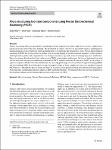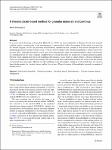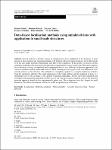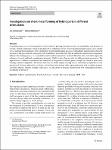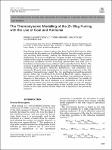Search
Author
- Amir, Ebrahimi (2)
- Aydin, Azizi (2)
- George, Haller (2)
- James, M. Fiore (2)
- next >
Subject
- robotics (9)
- Engineering (8)
- engineering (8)
- công nghệ (3)
- next >
Date issued
- 2020 - 2023 (215)
- 2010 - 2019 (28)
- 2001 - 2009 (6)
Has File(s)
- true (249)
Search Results
Surface structuring offers great potential for modifying frictional properties for various applications, such as complex forming processes like sheet-bulk metal forming. The production of surface structures in micrometre range is challenging for manufacturing processes in particular when machining hard-to-cut materials like hardened tool steels. Precise electrochemical machining (PECM) has great potential for surface structuring and shaping of metallic materials regardless of their hardness with high surface quality and comparatively very short process times, especially when structuring large areas and batches. Micro structuring of hardened tool steel surfaces using PECM is investigated in this paper. Surfaces of high-speed tool steel and hot-work tool steel are structured using a c... |
The present paper is devoted to the issue of the Green function matrices that belongs to some three-point boundary- and eigenvalue problems. A detailed definition is given for the Green function matrices provided that the considered boundary value problems are governed by a class of ordinary differential equation systems associated with homogeneous boundary and continuity conditions. The definition is a constructive one, i.e., it provides the means needed for calculating the Green function matrices. The fundamental properties of the Green function matrices—existence, symmetry properties, etc.—are also clarified. Making use of these Green functions, a class of three-point eigenvalue problems can be reduced to eigenvalue problems governed by homogeneous Fredholm integral equation syst... |
In a recent article (Frenning in Comp Part Mech 24:1–4, 2021), we demonstrated that a Delaunay-based strain estimate could be used as a starting point for the development of a particle-based method for continua. In this article, we argue that the Voronoi diagram, dual to the previously used Delaunay tetrahedralization, provides a more natural description of the underlying particulate system. For this reason, a Voronoi-based estimate of the deformation gradient is derived and used to the same effect. Although the gradient vectors cease to be antisymmetric, sums over nearest neighbors vanish, which results in a formulation that not only is linearly complete but also satisfies the patch test irrespective of initial particle placement. Pairwise forces, inferred from the local (nonaffine... |
Virgin olive oil processing results in a large amount of biomass (leaves, pomace, stones and wastewater) during harvesting, pruning and production. In recent years, these by-products have been studied as possible sources of bioactive compounds, and several techniques have been developed, including microwave, ultrasound, subcritical extraction, high hydrostatic pressure, a pulsed electric field, and high-voltage electrical discharge. However, these techniques can be expensive, and may require specialized staff to implement them. Therefore, this study proposes a novel method. Hydrodistillation is a simple and fast technique that can recover valuable compounds from olive oil biomasses. As it uses water as a solvent, it is sustainable, does not harm the environment, and is compatible wi... |
Several methods to localise sources of vibrations have been established in the literature. A great amount of those methods are based on databases with features of known impact positions. Great effort needs to be put into highly expensive experiments that deliver those databases. In this paper, we propose several simulation techniques that may replace the expensive experiments for source localisation. The paper compares the localisation accuracy of simulated and experimental data for two different localisation approaches, the reference database method and neural networks. Both methods process signal arrival time differences from several positions on the structure. The methods are exemplarily applied to a complex small-scale structure from the automotive industry: |
A novel equal atomic Ni–Al-Ti-Mn-Co-Fe–Cr high entropy alloy (HEA) was developed via the spark plasma sintering (SPS) process. This study investigates the influence of the sintering parametric processes, which consist of the sintering temperature (ST) and heating rate (HR) at constant pressure and dwelling time (DT) on the Microhardness (MH) and relative density (RD) of the developed HEA. Response surface methodology (RSM) was used to develop a predictive model. The design of experiment (DOE) approach was adopted to reduce the number of experiments and eliminate trial by error. ST and HR were considered model variables in developing the model. The user-defined design (UDD) under RSM was used to predict the optimal sintering parameters, and an experiment was conducted to validate the... |
Conventional processes are being pushed to their limits by growing demands in terms of sustainability and diversity of variants. Hybrid components, which are produced by a combination of two or more manufacturing processes, are a suitable way of meeting these challenges. The combination of sheet metal forming processes with additive manufacturing offers the potential to link personalized components with standardized parts. Knowing that the additively manufactured components influence the forming process, it is essential to understand the interactions in detail. Therefore, this work will compare the influence of several additively manufactured elements (AME) for deep drawing with two different punch geometries. The approach used combines experimental and numerical investigations to i... |
Human cyber-physical systems present an appealing platform for facilitating human-centered computing, particularly in environments where humans are required to interact with systems comprised of cyber and physical layers. Universally accepted elements of a human cyber-physical system, and interactions among these elements, do not appear to emerge in literature. To address this, a human cyber-physical system architecture is offered, led by the seafaring focus of this study. A human cyber-physical system implementation, called Mariner 4.0, for monitoring motion sickness of seafarers is presented to demonstrate the operation of a human cyber-physical system as a platform for human-centered computing. The human cyber-physical system implementation enabled the digital representation of t... |
Slag fuming process is used to extract zinc from the lead blast furnace slags and recently for the extraction of multiple elements from the complex primary and recycling feed streams, making the thermochemistry of the process challenging. To meet new challenges, computer models with predictive powers outside of the range of normal process conditions are necessary. These models cannot rely exclusively on sets of existing process data and must have a foundation in thermodynamics combined with reasonable kinetic factors. The accuracy of predictions largely depends on the quality of thermodynamic data, including phase equilibria, elemental distributions, and calorimetry measurements. Present study demonstrates the recent developments of the self-consistent thermodynamic model for the ga... |
The current study investigates the stability structure of the base periodic motion of an inverted pendulum (IP). A uniform magnetic field affects the motion in the direction of the plane configuration. Furthermore, a non-conservative force as one that dampens air is considered. Its underlying equation of motion is derived from traditional analytical mechanics. The mathematical analysis is made simpler by substituting the Taylor theory in order to expand the restoring forces. The modified Homotopy perturbation method (HPM) is employed to achieve a roughly adequate regular result. To support the prior result, a numerical method based on the fourth-order Runge-Kutta method (RK4) is employed. The graphs for both the analytic and numerical solutions are highly consistent with one another... |

